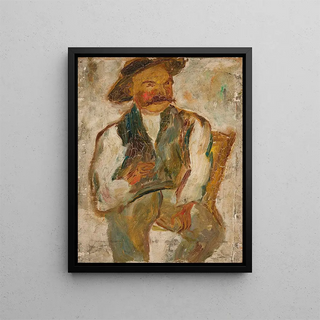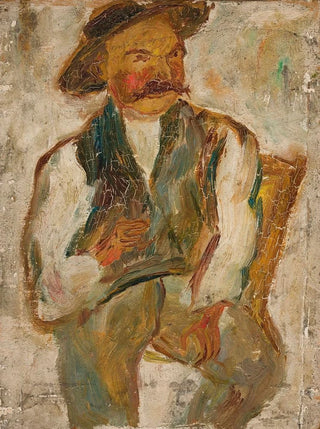Art print | Study of a peasant with hat - Tadeusz Makowski


View from behind

Frame (optional)
Reproduction of "Study of a Peasant with a Hat" by Tadeusz Makowski – A captivating introduction
The artwork "Study of a Peasant with a Hat" by Tadeusz Makowski serves as a fascinating gateway into the artistic universe of the early 20th century. In this piece, the Polish artist captures not only the essence of a rural character but also the soul of an era marked by profound social and economic changes. This painting, imbued with simplicity and depth, evokes a direct connection to peasant life while revealing the unique sensitivity of its creator. The art print of this work allows for a full appreciation of the dialogue between form and content, where each brushstroke seems to tell a story.
Style and uniqueness of the work
The uniqueness of "Study of a Peasant with a Hat" lies in its style, which combines the rigor of drawing with a carefully chosen color palette. The peasant, with an expressive face and iconic hat, is depicted in a posture that suggests both dignity and fatigue of a farm worker. The composition is balanced, with soft shapes contrasting with more defined lines, creating a striking visual dynamism. Makowski, influenced by the expressionist movement, manages to infuse palpable emotion through meticulous details, such as the delicately cast shadows on the protagonist's face. This work also stands out for its ability to transcend the simple portrait to become a true reflection on the human condition, on labor and the pride of men and women of the land.
The artist and his influence
Tadeusz Makowski, born in Poland in 1882, is an artist whose work has been shaped by a multitude of influences, ranging from cubism to expressionism. His career, marked by travels to Paris and Berlin, allowed him to mingle with major figures of modern art, while developing a style that is uniquely his own. Makowski is distinguished by his ability to incorporate Polish folk elements into a modern artistic language, thus creating a work deeply rooted in his cultural identity. His approach to the peasant subject, often considered banal, becomes a means to explore

Matte finish

View from behind

Frame (optional)
Reproduction of "Study of a Peasant with a Hat" by Tadeusz Makowski – A captivating introduction
The artwork "Study of a Peasant with a Hat" by Tadeusz Makowski serves as a fascinating gateway into the artistic universe of the early 20th century. In this piece, the Polish artist captures not only the essence of a rural character but also the soul of an era marked by profound social and economic changes. This painting, imbued with simplicity and depth, evokes a direct connection to peasant life while revealing the unique sensitivity of its creator. The art print of this work allows for a full appreciation of the dialogue between form and content, where each brushstroke seems to tell a story.
Style and uniqueness of the work
The uniqueness of "Study of a Peasant with a Hat" lies in its style, which combines the rigor of drawing with a carefully chosen color palette. The peasant, with an expressive face and iconic hat, is depicted in a posture that suggests both dignity and fatigue of a farm worker. The composition is balanced, with soft shapes contrasting with more defined lines, creating a striking visual dynamism. Makowski, influenced by the expressionist movement, manages to infuse palpable emotion through meticulous details, such as the delicately cast shadows on the protagonist's face. This work also stands out for its ability to transcend the simple portrait to become a true reflection on the human condition, on labor and the pride of men and women of the land.
The artist and his influence
Tadeusz Makowski, born in Poland in 1882, is an artist whose work has been shaped by a multitude of influences, ranging from cubism to expressionism. His career, marked by travels to Paris and Berlin, allowed him to mingle with major figures of modern art, while developing a style that is uniquely his own. Makowski is distinguished by his ability to incorporate Polish folk elements into a modern artistic language, thus creating a work deeply rooted in his cultural identity. His approach to the peasant subject, often considered banal, becomes a means to explore






